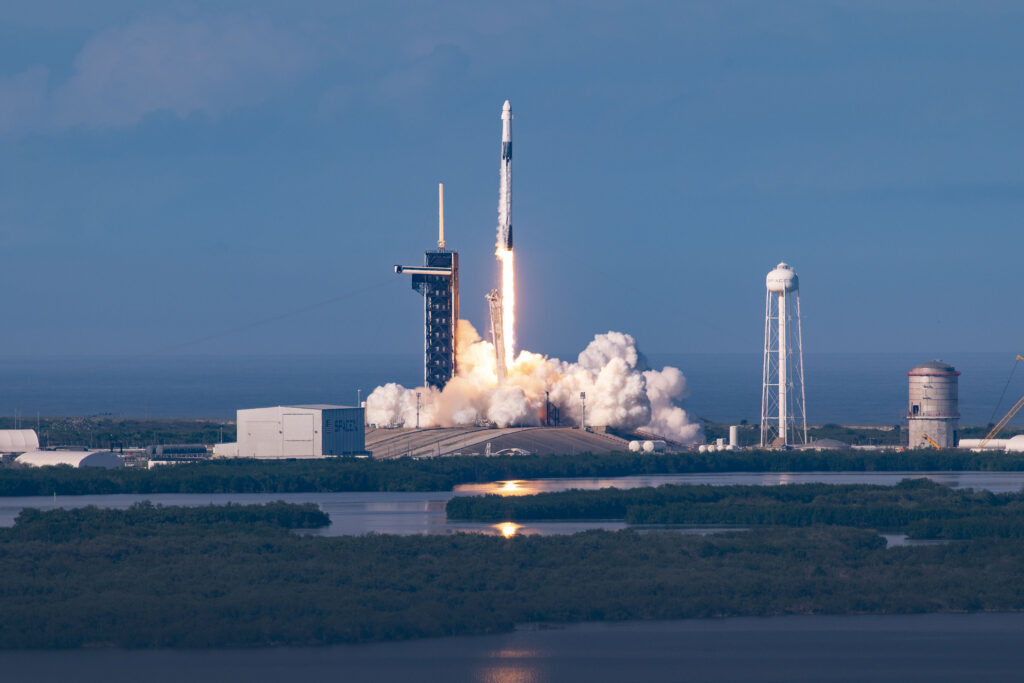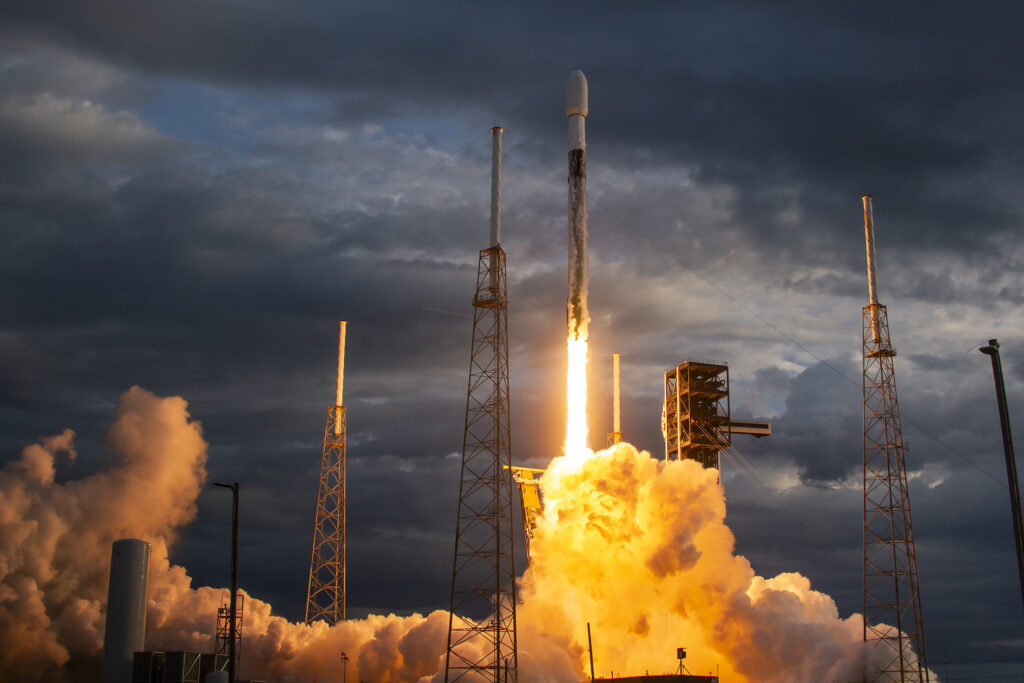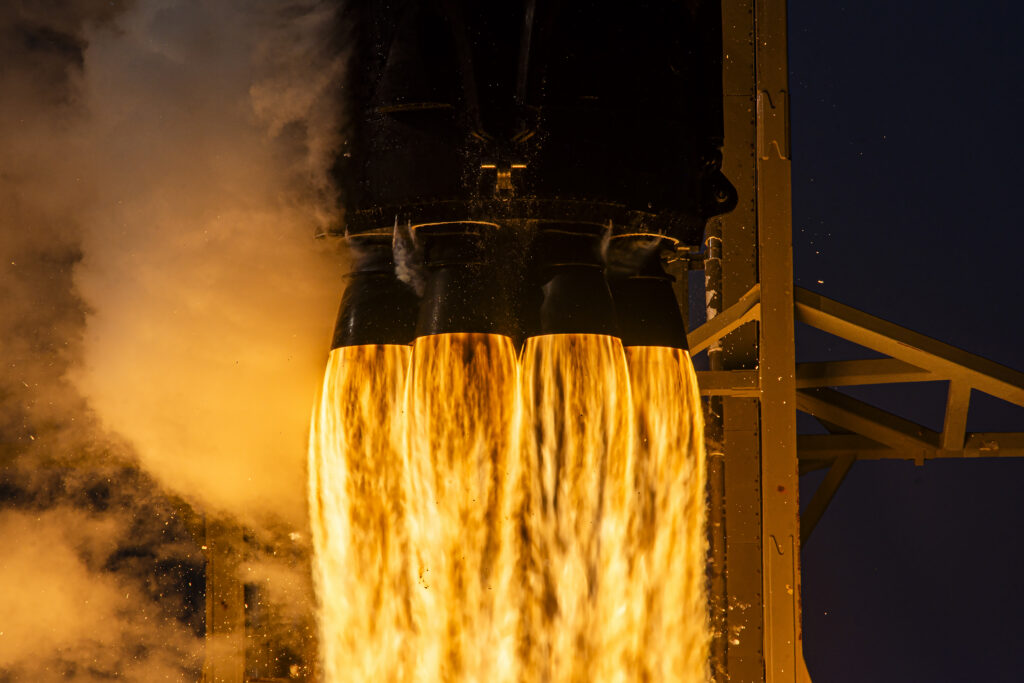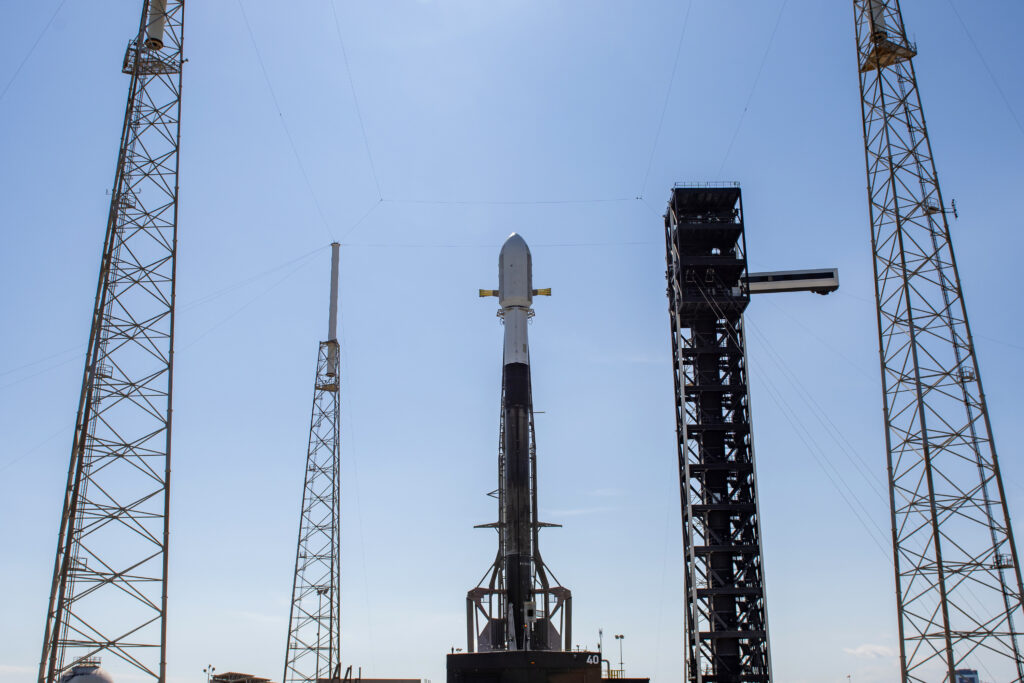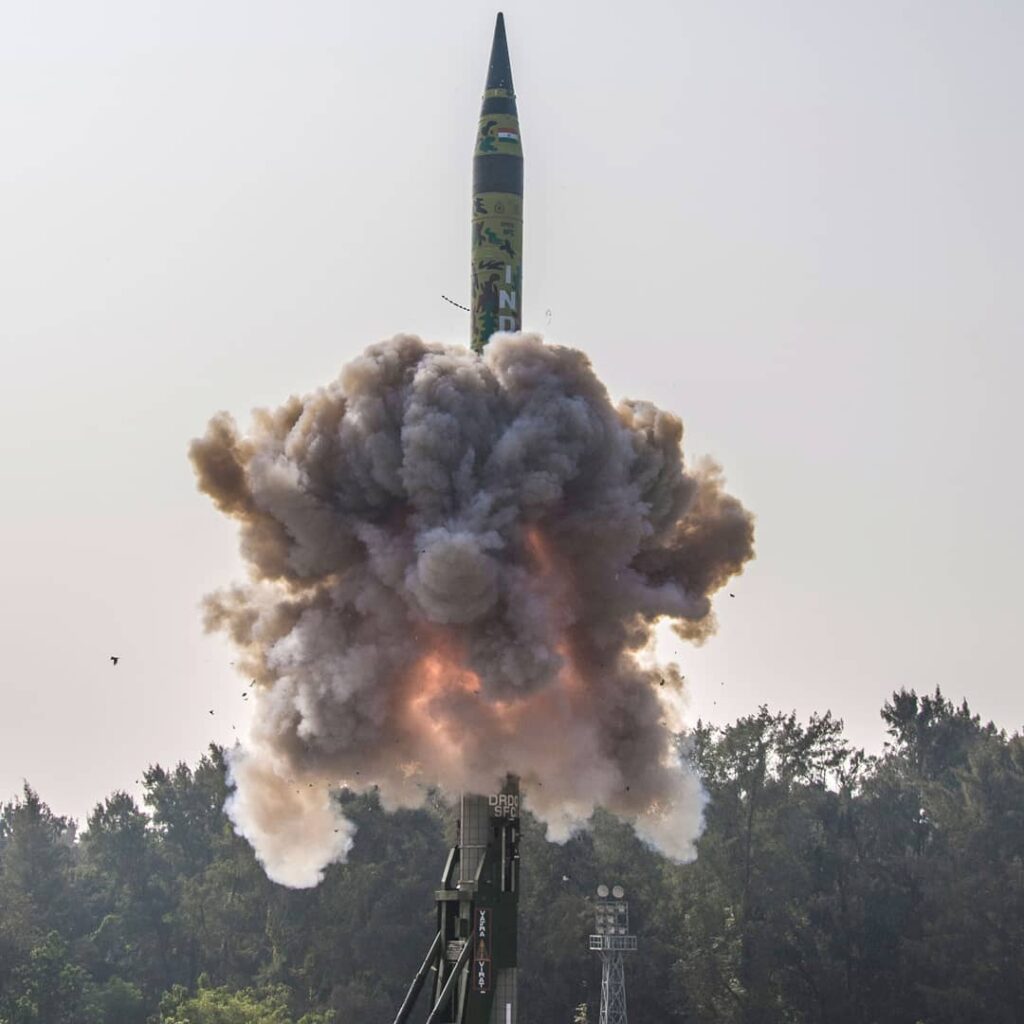In another milestone for global satellite communications and SpaceX’s record-breaking launch cadence, SpaceX successfully launched the SpainSat NG II communications satellite on Thursday night (October 23, 2025) from the Cape Canaveral Space Force Station in Florida. The mission, carried out using a Falcon 9 rocket, marked the company’s 139th orbital launch of 2025, reinforcing SpaceX’s unmatched dominance in the commercial launch industry.
The mission, delayed by a day due to unfavorable weather conditions, culminated in a flawless liftoff from Space Launch Complex 40 (SLC-40) at approximately 11:58 p.m. EDT. The powerful two-stage Falcon 9 propelled SpainSat NG II, a 6.1-ton next-generation communications satellite, into a geosynchronous transfer orbit (GTO) a high-energy orbit essential for satellites providing broad regional coverage.
Built by Airbus Defence and Space for Hisdesat Servicios Estratégicos S.A., the state-owned Spanish satellite operator, SpainSat NG II represents the latest advancement in secure, resilient, and high-capacity communications for defense and government users across multiple continents.
A Leap Forward in Secure Communications
The SpainSat NG II satellite is the second in the SpainSat Next Generation (NG) series, following the successful launch of SpainSat NG I earlier this year. Together, the two satellites are designed to replace and expand the capabilities of Hisdesat’s existing SpainSat and XTAR-EUR satellites, which have served since the early 2000s.
This new generation offers 16 times the data capacity of its predecessors, operating in both the X-band and Ka-band frequencies. These frequency ranges are vital for secure communications, especially in military, governmental, and emergency response applications.
According to Airbus, SpainSat NG II integrates cutting-edge digital payload technology capable of dynamic beam reconfiguration, anti-jamming resilience, and secure encryption, enabling adaptive and high-speed communications even in contested environments.
The satellite will provide coverage over Europe, the Americas, Africa, and parts of Asia, serving as a strategic communications asset for Spain and allied nations. Its 15-year design life ensures long-term operational reliability, supporting NATO and EU defense communications as well as humanitarian and disaster-response coordination.
Built by Airbus, Powered by Innovation
The spacecraft was developed under the leadership of Airbus Defence and Space, with participation from Spanish industry partners such as Thales Alenia Space Spain and Indra, ensuring significant local industrial involvement.
The SpainSat NG program was co-financed by Spain’s Ministry of Defense and Hisdesat, with oversight from the European Space Agency (ESA) and the Spanish Centre for the Development of Industrial Technology (CDTI) under the European Union’s ARTES (Advanced Research in Telecommunications Systems) program.
Airbus integrated advanced Eurostar Neo platform technologies into SpainSat NG II, which provide improved payload power, more efficient propulsion systems, and enhanced digital flexibility. The spacecraft’s fully electric propulsion system reduces overall launch mass while enabling precise orbit raising and long-term station-keeping.
SpaceX’s Falcon 9: A Proven Workhorse
The Falcon 9 rocket, which carried SpainSat NG II into orbit, is SpaceX’s cornerstone vehicle for both commercial and government launches. Thursday’s mission was particularly notable as it marked the final flight for booster B1076, one of SpaceX’s most seasoned first stages.
Having flown 22 missions over its operational lifespan a record-tying figure among Falcon 9 boosters B1076’s legacy includes multiple Starlink deployments, cargo missions to the International Space Station (ISS), and various commercial payload deliveries.
However, for the SpainSat NG II mission, SpaceX chose to expend the booster in the Atlantic Ocean after stage separation due to the high-energy requirements of the geosynchronous transfer orbit. The demanding trajectory necessitated all available propellant to maximize performance, leaving insufficient fuel for a controlled landing.
Despite the loss of the booster, the decision reflects SpaceX’s pragmatic approach: prioritizing mission success and orbital accuracy for high-value payloads over reusability when necessary.
Mission Details and Deployment
After liftoff, the Falcon 9’s first stage completed its standard ascent profile, separating approximately 2.5 minutes after launch. The second stage ignited its Merlin Vacuum engine, continuing to propel the payload toward its planned orbit. Roughly 35 minutes post-launch, the SpainSat NG II satellite was successfully deployed into its preliminary geosynchronous transfer orbit.
Following deployment, SpainSat NG II will undergo a multi-week orbit-raising phase, during which its onboard electric thrusters will circularize its orbit at approximately 35,786 kilometers (22,236 miles) above Earth. Once in its final geostationary position, the satellite will undergo in-orbit testing before entering full operational service by early 2026.
Hisdesat’s Strategic Role in Spain’s Defense and Beyond
Founded in 2001, Hisdesat Servicios Estratégicos S.A. plays a critical role in providing secure satellite communications, Earth observation, and maritime traffic monitoring for Spain and allied nations. The SpainSat NG program marks a significant evolution in Hisdesat’s ability to support defense, intelligence, and government operations globally.
In a post-launch statement, Hisdesat CEO Miguel Ángel Panduro praised the collaboration between Spanish and European partners, saying:
“SpainSat NG II represents a major step forward in Spain’s secure communications infrastructure. Together with SpainSat NG I, it will provide unprecedented capabilities to support both national and international defense and security missions.”
He also acknowledged SpaceX’s role in ensuring a timely and precise launch, adding:
“The partnership with SpaceX and Airbus demonstrates the best of transatlantic collaboration in advancing secure space-based technologies.”
Airbus and Thales: Strengthening Europe’s Space Industry
The SpainSat NG program underscores Europe’s growing independence and competitiveness in satellite technology. Airbus Defence and Space, with Thales Alenia Space Spain and other local partners, have leveraged this program to strengthen Europe’s capabilities in secure communications, resilience, and digital innovation.
Jean-Marc Nasr, Head of Airbus Space Systems, said after the launch:
“SpainSat NG II showcases Europe’s ability to deliver next-generation satellites with the highest levels of flexibility, power, and cyber resilience. It’s a testament to our partnership with Hisdesat and the Spanish government.”
The program also supports Spain’s national space strategy, which emphasizes greater industrial participation, defense autonomy, and international collaboration within NATO and the EU framework.
SpaceX’s Record-Breaking 2025 Launch Pace
For SpaceX, this mission further cements a year of historic achievements. The company has now conducted 139 orbital launches in 2025 alone, averaging more than one launch every two and a half days an unprecedented cadence in the history of rocketry.
Most of these missions have been powered by the Falcon 9, while several utilized Falcon Heavy and Starship, SpaceX’s next-generation fully reusable super-heavy launch system.
The SpainSat NG II launch also adds to SpaceX’s growing international portfolio, reinforcing its position as the launch provider of choice for governments and commercial operators worldwide. The company continues to maintain a remarkable success rate exceeding 99% across its missions this year.
With reusability, reliability, and rapid turnaround, SpaceX has revolutionized how the world approaches space access. Although the retirement of booster B1076 marks the end of a chapter, the legacy of the Falcon 9 fleet continues as new boosters are rapidly produced, reflown, and upgraded.
The Future of Secure Satellite Networks
The deployment of SpainSat NG II represents more than a technological achievement; it signals a broader shift toward next-generation, digitally reconfigurable, and secure communications infrastructures in orbit.
As cyber threats grow and global defense operations become increasingly dependent on resilient networks, satellites like SpainSat NG II will serve as crucial links for intelligence, surveillance, reconnaissance, and command-and-control systems.
Moreover, the SpainSat NG constellation supports multi-domain interoperability, allowing allied nations to share data securely across platforms and geographies — an essential component of modern defense operations.
With both satellites in place, Hisdesat will have the flexibility to redirect capacity in real-time, respond to emergencies, and ensure consistent connectivity even under duress or in contested regions.
A Milestone for Spain and SpaceX
Thursday’s successful launch of SpainSat NG II stands as a symbol of technological collaboration, strategic foresight, and global partnership. For Spain, it represents a leap forward in its defense communications capabilities. For Airbus and Europe, it highlights the growing strength of the continent’s space industry. And for SpaceX, it adds another feather to its already record-setting year of launches.
As the satellite begins its operational life high above Earth, it not only strengthens Spain’s position in space-based communications but also exemplifies how public-private partnerships and global cooperation can drive innovation and security in the new space era.
With the Falcon 9 B1076 retired in spectacular fashion and SpaceX moving steadily toward new frontiers with Starship, the success of this mission reinforces one truth:
Space exploration and satellite technology are not slowing down they’re accelerating into a new age of global connectivity and collaboration.
Related News: Read More

